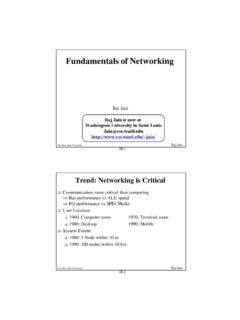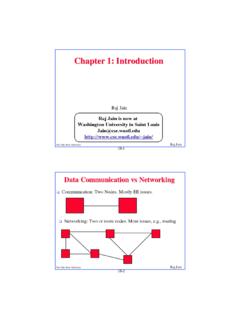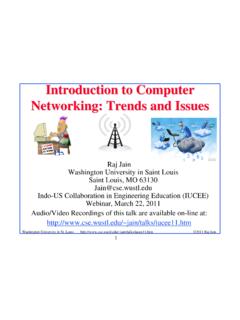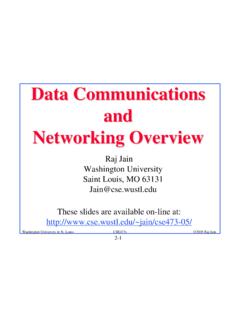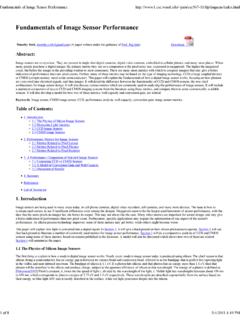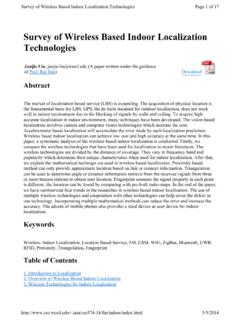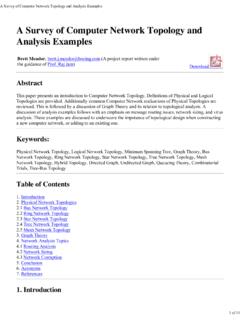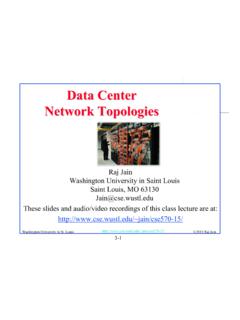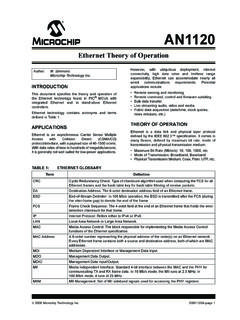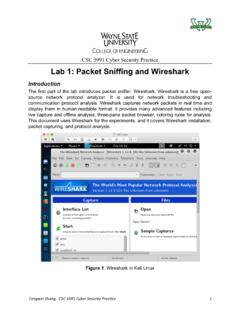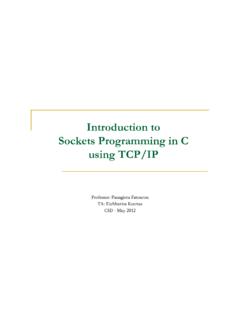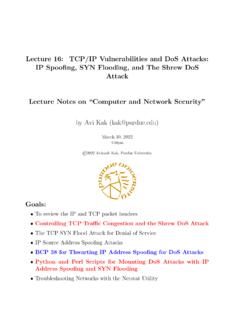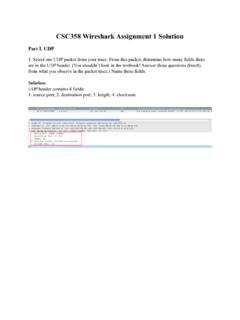Transcription of Introduction to TCP/IP
1 1 2002 Raj JainIntroduction Introduction to TCP/IPto TCP/IPThe Ohio State University Columbus, OH 43210 Nayna NetworksMilpitas, CA 95035 Raj JainEmail: 2002 Raj JainOverviewOverview!Internetworking Protocol (IP)!IP Addressing!Domain Name System!Routing Protocols: RIP, OSPF, BGP!Transport Protocols: TCP, UDP3 2002 Raj JainTCP/IP Reference ModelTCP/IP Reference Model!TCP = Transport Control Protocol!IP = Internet Protocol (Routing)ApplicationPresentationSessionT ransportNetworkDatalinkPhysicalApplicati onTransportInternetworkHost to NetworkIPFTPTCPT elnetHTTPUDPE thernetPacketRadioPoint-to-PointTCP/IP ModelOSI Ref ModelTCP/IP Protocols4 2002 Raj JainLayered Packet FormatLayered Packet Format!Nth layer control info is passed as N-1th layer : File Transfer Protocol (FTP)FTP DataFTP HeaderTCP DataTCPH eaderIP DataIPHeaderEthernet DataEthernetHeaderEthernetTrailer5 2002 Raj JainInternetworkingInternetworking!Inter -network = Collection of networks Connected via routersNetworkNetworkNetworkNetworkRoute rRouter6 2002 Raj JainInternet = Collection of NetworksInternet = Collection of Networks!
2 Any computer can talk to any other computerNet 2 Net 1 Net 3 Net 47 2002 Raj JainInternet Protocol (IP)Internet Protocol (IP)!Layer 3 protocol that forwardsdatagrams across internet!Uses routing tables prepared by routing protocols, , Open Shortest Path First (OSPF),Routing Information Protocol (RIP)!Connectionless servicevs connection-oriented (circuits)8 2002 Raj JainIP Datagram FormatIP Datagram FormatVersionHeader LenService TypeTotal LengthIdentificationFlagsTime to livePayload TypeHeader ChecksumFragment OffsetSource IP AddressDestination IP AddressIP Options (May be omitted)PaddingData9 2002 Raj JainIP AddressingIP Addressing!All IP hosts have a 32-bit 0000 0000 1010 0000 0000 0000 0001!All hosts on a network have the same network 2002 Raj JainSubnettingSubnetting!All hosts on a subnetwork have the same of the prefix is indicated by a subnet mask !Example: First 23 bits = subnetAddress: 10010100 10101000 00010000 11110001 Mask:11111111 11111111 11111110 10101000 00010000 00000000 Subnet 1 Subnet 2 Subnet nNetwork11 2002 Raj JainForwarding an IP DatagramForwarding an IP Datagram!
3 Delivers datagrams to destination network (subnet)!Routers maintain a routing table of next hops !Next Hop field does not appear in the datagramTable at R2:Net 1 Forward to R1 Net 2 Deliver DirectNet 3 Deliver DirectNet 4 Forward to R3 Net 1 Net 1R1R1 Net 2 Net 2R2R2 Net 3 Net 3R3R3 Net 4 Net 4 DestinationNext Hop12 2002 Raj JainPrivate AddressesPrivate Addresses!Any organization can use these inside their networkCan t go on the internet. [RFC 1918]! - (10/8 prefix)! - ( prefix)! - ( prefix)NetworkAddressTranslatorPrivateNe tworkInternetPrivateAddressesPublicAddre sses13 2002 Raj JainDomain Name ServiceDomain Name Service!Computers use addresses!Humans cannot remember IP addresses Need namesExample, Liberia for !Simplest Solution: Each computer has a unique name and has a built in table of name to address translation!Problem: Not scalable!Solution: DNS (Adopted in 1983)!Hierarchical Names: 2002 Raj JainName HierarchyName Hierarchyrestoncomedugovauusdecohio-stat ensfcovacisnetlabeecnriUnnamed 2002 Raj JainName HierarchyName Hierarchy!
4 Unique domain suffix is assigned by Internet Assigned Number Authority (IANA)!The domain administrator has complete control over the domain!No limit on number of sub-domains or number of levels! !Name space is not related to physical interconnection, , and could be on the same floor or in different cities16 2002 Raj JainName ResolutionName ResolutionUserNameResolverNameServerName ServerCacheCacheCacheQueryReferralQueryR esponseQueryResponseData-baseData-baseNa meServerCacheData-baseQueryResponse17 2002 Raj JainName Resolution (Cont)Name Resolution (Cont)!Each computer has a name resolver routine, , gethostbyname in UNIX!Each resolver knows the name of a local DNS server!Resolver sends a DNS request to the server!DNS server either gives the answer, forwards the request to another server, or gives a referral!Referral = Next server to whom request should be sent!Servers respond to a full name onlyHowever, humans may specify only a partial nameResolvers may fill in the rest of the suffix, , = 2002 Raj JainAutonomous SystemsAutonomous Systems!
5 An internet connected by homogeneous routers under the administrative control of a single entitySubnet 2002 Raj JainRouting ProtocolsRouting Protocols!Interior Router Protocol (IRP): Among routers internal to an autonomous system. Also known as IGP.!Examples: Routing Information Protocol (RIP), Open Shortest Path First (OSPF)!Exterior Router Protocol (ERP): Among routers between autonomous systems. Also known as EGP.!Examples: Exterior Gateway Protocol (EGP), Border Gateway Protocol (BGP), Inter-Domain Routing Protocol (IDRP)Note: EGP is a class as well as an instance in that 2002 Raj JainRouting Information ProtocolRouting Information Protocol!RIP uses distance vector A vector of distances to all nodes is sent to neighbors every 30 seconds!Each router computes new distances and replaces entries with new lower hop counts21 2002 Raj JainShortcomings of RIP V1 Shortcomings of RIP V1!Maximum network diameter = 15 hops!Cost is measured in hopsOnly shortest routes.
6 May not be the fastest route.!Entire tables are broadcast every 30 intensive.!Uses UDP with 576-byte datagrams . Need multiple table needs 12 datagrams .!An error in one routing table is propagated to all routers!Slow convergence22 2002 Raj JainOpen Shortest Path First (OSPF)Open Shortest Path First (OSPF)!Uses true metrics (not just hop count)!Allows load balancing across equal-cost paths!Authenticates route exchanges!Quick convergence!Large networks are subdivided into a backbone network and areas!Each area has multiple subnets. Each subnet has a designated router. !Link state routing Each router broadcasts its connectivity with neighbors to entire area23 2002 Raj JainRouter TypesRouter TypesAnotherAutonomousSystemAreaBorderRo uterBackboneRouterDesignatedRouterBackup DRASB oundaryRouterBackboneRouterArea 4 Area 1 Area 2 InternalRouterBackbone24 2002 Raj JainRouter Types (Cont)Router Types (Cont)!Internal Router (IR): All interfaces belong to the same area!
7 Area Border Router (ABR):Interfaces to multiple areas!Backbone Router (BR):Interfaces to the backbone!Autonomous System Boundary Router (ASBR):Exchanges routing info with other autonomous systems!Designated Router (DR):Generates link-state info about the subnet!Backup Designated Router (BDR):Becomes DR if DR 2002 Raj JainOSPF OperationOSPF Operation!Periodic Hello packets are multicast on the subnet to find other routers and elect designated router and backup designated router !Designated routers and routers on point-to-point links form adjacency. Exchange Link State Advertisements (LSAs). New info flooded to all other adjacent routers in the area.!Area border routers (ABRs) send summary LSAs to other ABRs!Autonomous system border routers (ASBRs) use exterior routing protocol to exchange routing information26 2002 Raj JainBorder Gateway ProtocolBorder Gateway Protocol!Inter-autonomous system protocol [RFC 1267]!Used since 1989 but not extensively until recently!
8 Advertises all transit ASs on the path to a destination address!A router may receive multiple paths to a destination Can choose the best path27 2002 Raj JainBGP OperationsBGP Operations!BGP systems initially exchange entire routing , only updates are exchanged.!BGP messages have the following information:!Origin of path information: RIP, OSPF, ..!AS_Path: List of ASs on the path to reach the dest!Next_Hop: IP address of the border router to be used as the next hop to reach the dest!Unreachable: If a previously advertised route has become unreachable!BGP speakers generate update messages to all peers when it selects a new route or some route becomes 2002 Raj JainTCP: Key FeaturesTCP: Key Features!Point-to-point communication: Twoend-points!Connectionoriented. Full duplex communication.!Reliabletransfer: Data is delivered in orderLost packets are retransmitted.!Streaminterface: Continuous sequence of octets29 2002 Raj JainTransport Control Protocol (TCP)Transport Control Protocol (TCP)!
9 Key Services:!Send: Please send when convenient !Data stream push: Please send it all now, if possible.!Urgent data signaling: Destination TCP! please give this urgent data to the user(Urgent data is delivered in sequence. Push at the should be explicit if needed.)!Note: Push has no effect on delivery. Urgent requests quick delivery30 2002 Raj JainTCP Header FormatTCP Header Format161632326 SourcePortDestPortSeqNoAckNoDataOffsetCo ntrolWindowResvd46161616xySize in bitsCheck-sumUrgentOptionsPadDataFTP HTTP SMTP31 2002 Raj JainTCP HeaderTCP Header!Source Port (16 bits): Identifies source user process20 = FTP, 23 = Telnet, 53 = DNS, 80 = HTTP, ..!Destination Port (16 bits)!Sequence Number (32 bits): Sequence number of the first byte in the segment. !Ack number (32 bits): Next byte expected!Data offset (4 bits): # of 32-bit words in the header!Reserved (6 bits) !Window (16 bits): Will accept [Ack] to [Ack]+[window]32 2002 Raj JainUser Datagram Protocol (UDP)User Datagram Protocol (UDP)!
10 Connectionlessend-to-end service!Unreliable: No flow control. No error recovery (No acks. No retransmissions.)!Used by network management and Audio/Video. !Provides port addressing!Error detection (Checksum) optional. SourcePortDestPortCheck-sumLength161616 Size in bits16 Data33 2002 Raj JainSummarySummary!IP is the forwarding protocol between networks!IPv4 uses 32-bit addresses !DNS: Maps names to addresses!OSPF uses link-state advertisements!BGP is used between autonomous systems!TCP provides reliable full-duplex connections.!UDP is connectionless and simple. No flow/error 2002 Raj JainHomework 2 Homework 2 True or False?T F" "A sample IP address is " " Two computers cannot have the same IP address" " Two computers cannot have the same complete DNS name" " IANA assigns all names used inside a company." " Each DNS server database stores all computer names in the world." " Routing tables used by IP are prepared using routing protocols like OSPF, BGP.
